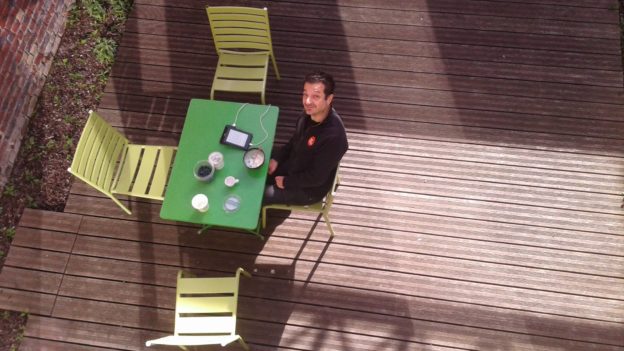TL;dr
Artificial intelligence and the blockchain are the two main technological hypes of the past fifteen years. Both were hailed as technologies with the potential to solve many problems and change the world, for the better. It now looks like their impact is overwhelmingly negative. Though they could be used for the common good, it turns out they are not very good at that. They are better, far better at harming humans than at helping them. They encode dystopian, sociopathic world views; and tend to attract developers, investors and entrepreneurs that share those world views. So, once deployed, they tend to bring the world closer to them. They are sociopathic tech.
This is disturbing, because mostly everyone fell for them: investors, developers, entrepreneurs, academics, government officials. I call for a re-examination of the achievements of these technologies and the impact they are having on our life and our societies. I would like to see support to innovation systems depend on how new technologies improve the well-being of humans and of the planet, and only on that. In what follows, I review some of the facts as a discussion starter.
Of how Artificial Intelligence excels at everything, except solving problems that matter
I recently had the opportunity to be exposed to the work of Juan Mateos-Garcia, a leading data scientist. Juan and his team had been looking at a large dataset of science papers published on the topic of Artificial Intelligence (AI). Their results look like this:
- AI has been undergoing a revolution since about 2012, when deep learning started to systematically outperform established techniques.
- Scientific production (papers) is booming. AI is shaping to be a general-purpose technology, like electricity or computing itself.
- Industry interest is evident. Many top scientists have been recruited from academia into industry. Venture capitalists have moved to invest in AI startups. Major governments are underwriting large public investments. There are talks of a “AI arms race” between China, the USA and the EU.
- AI is dominated by a small number of organisations and geographic clusters. Diversity of its workforce has stagnated.
- AI has had no impact on the effort to beat back the COVID-19 pandemic. In fact, all other things being equal, a paper on COVID is more likely to be cited by other papers if it is not about AI.
This final point gave me pause. Something was off. Why would AI not make a valid contribution to fighting the COVID plague? The conditions all seemed to be in place: there was, and still is, plenty of funding for research on COVID. There is a large, inelastic demand for the applications of that research, like vaccines. There is plenty of training data being generated by health care institutions the world over. And, if AI is a general purpose technology, it should apply to any problem, including COVID. The most exciting technology of the moment somehow failed to contribute to solving the most pressing problem of the moment. Why is that?
I can imagine a world where AI is deployed to help in the fight against a pandemic. Wen would use it to engineer a more targeted response to the risks of contagion. Granular risk scores could be associated to individual people and different situations, allowing society to protect the most vulnerable people from the riskiest situations, while leaving low-risk individuals in low-risk contexts free to get on with their lives.
Sounds good, but that world is not the one we live in. In our world, AI-powered, individually customized COVID restrictions would run into non-tractable problems. First, the algos would seize the high correlation between different socio-demographic variables, and decide that poor people, people of color and (in America) trumpists are more prone to the contagion, and should stay at home more than white, affluent liberals. Discriminated groups would react fighting back, challenging the algos as biased, starting litigation and inviting to civil disobedience, as is happening time and time again.
Even if there was no conflict and everybody trusted the algos, it is not clear how we would use effectively the predictions they make for us. First of all, there is the cognitive challenge of understanding the predictions. You could tell someone something like this: “the risk of catching COVID on public transport for someone with your demographic profile went up 20% today, avoid the bus if you can”. But that is unlikely to work, because
- Most people do not understand risk. For example, they are more scared of terrorist attacks than they are of car crashes, though the latter are far more frequent (hence more dangerous) than the former.
- AI is Bayesian statistics, and as such it makes prediction not on you, but on somebody who is like you in a quantifiable way. It leaves out everything that makes you unique, putting it in the error term. For example, imagine you are a 45-year old living in the Netherlands who is also an ultra-marathoner. The algo computing your risk factor processes your age and the country you live in, because it has thick enough data in those dimensions. Your ultramarathons stay in the error term, because there are not enough people doing ultramarathons for that activity to be tracked in its own variable. And yet, when looking at the overall resilience of your organism, this is clearly an important information.
Given this situation, I suspect most people would end up following their own belief system rather than the algo’s recommendations. People who fancy themselves strong and resilient might say “yes, this gizmo is predicting high risk, but it is not talking about me, I am healthier and stronger than most!”. Or, vice versa, “yes, a low risk is predicted for outdoor mingling, but with my history of allergies I still don’t feel safe”. This is de facto happening right now with how people process scientific findings about COVID-19. Some people prefer to trust their own immune systems over the pharma-punditry complex. Others made COVID restrictions into some kind of weird religion, following them “above and beyond” even when science is calling for their relaxations. Even if a good AI-powered risk prediction system were in place , many humans are way too irrational to take full advantage of it. They prefer simple rules, applicable to all: “1.5 meters”, “wash your hands” and such. The promise of AI, providing personalized recommendation to each and every one of us, clashes with the human need for stability and security.
In conclusion, AI had no grip on COVID, and is unlikely to have any grip on any similar high-stakes problem. So, what is AI good for? We can start with the applications already being developed:
With the exception of machine translation, these applications are all detrimental to human well-being, for world-eating values of “detrimental”. We are seeing yet another example of Kranzberg’s First Law in action: AI is not good, nor is it evil, nor is it neutral. It could be used for good, though I am unconvinced it would work very well: but it is when you use it for evil, dehumanizing purposes that it really shines.
That such a potentially toxic technology is attracting so much attention, public funding and private investment is a spectacular societal and policy failure. And that brings me to the blockchain.
Of the blockchain and its discontents
The blockchain, as by now everyone had to learn, is the name of a family of protocols that allow data storage not in a single repository, but in many. Using cryptography, the different computers who adhere to the same protocol validate each other’s copy of the database. This prevents a “rogue” participant from altering the records, as the alteration would only be present in a single computer and not be validated by the others. This system was first proposed to solve a problem called double spending when no trusted, centralized authority is present.
That was 2008. In these 13 years, blockchain solutions have been proposed for many, many problems. To my knowledge, none worked, or at least none worked any better than competing solutions that used a more conventional database architecture. This makes sense, because blockchains are self-contained systems. They use cryptography to certify that in-database operations, but they cannot certify anything that exists outside the database. Any system based on a blockchain relies on external sources of information, known as “oracles”. For example, if you were to build an identity system based on the blockchain, you would have to start by associating your name, date of birth etc. to a long string of digits. Once stored on the blockchain, the association is preserved, but some external “oracle” has to certify it before it gets stored. In the absence of a credible external certification, the system could work technically, but it would produce no impact. I could create my own identity system, but no one would use it, because I am not trustable enough when I issue a digital ID to your name. There are entities with the trustability to start such a system, for example major governments. But, because they are trustable, they do not need the blockchain at all. I have lost count of technologists who told me:
Any technology which is not an (alleged) currency and which incorporates blockchain anyway would always work better without it. (source)
But the blockchain is not just another clever technical solution in search of a problem to solve. I argue it is a major source of problems in itself. Consider this:
- The distribution of Bitcoins is extremely unequal, with a Gini coefficient estimated at 0.95 in 2018 (theoretical maximum: 1; Lesotho, the most unequal country on the planet for which we have data: 0.65). In fact, inequality seems to be a feature of blockchains, not just of Bitcoin – for example, it is estimated that the bulk of the monetary value conjured by Ethereum-based non-fungible tokens (NFTs) is appropriated by “already big-name artists and designers”.
- Blockchains use a lot of power. Every update anywhere in the system needs to be validated by network consensus, which includes a lot of computers exchanging data. Bitcoin alone consumes about 150 Terawatt per hour, more than Argentina. Providing computer power to the Bitcoin network is rewarded in Bitcoins, through a process known as “mining”: this provides the incentive to underwrite all this computation. In bid to make what they see as easy money, Bitcoin miners have resorted to malware that infects people’s computers and gets them to compute SHA-256 , incorporated into the builds of open source software projects; resurrected mothballed power stations that burn super-dirty waste coal; installed mining operations in Iranian mosques (which get electricity for free) and engaged in plain stealing. Their carbon footprint is enormous: one Bitcoin transaction generates the same amount of CO2 as 706,605 swipes of a Visa credit card. Some blockchains have less computationally expensive systems of verifications, but they are still more energy- and CO2-intensive than traditional databases.
- Fraud – especially to the detriment of less experienced investors – is rampant in crypto.
- Crypto has provided a monetization channel for ransomware attacks. Ransoms are demanded and paid in Bitcoin, untraceable by Interpol. Some observers go so far as to claim that the price of Bitcoin is tied to the volume of ransomware attacks. Hospitals and other health care institutions are among the main targets of these attacks: not only do they have to pay money, but their IT systems shut down, threatening the lives of patients.
- In 2021, tech companies that used to donate CPU power to legitimate projects have had to stop doing so, citing the constant abuse from crypto miners. It is worth quoting the words of Drew DeVault:
Cryptocurrency has invented an entirely new category of internet abuse. CI services like mine are not alone in this struggle: JavaScript miners, botnets, and all kinds of other illicit cycles are being spent solving pointless math problems to make money for bad actors. […] Someone found a way of monetizing stolen CPU cycles directly, so everyone who offered free CPU cycles for legitimate use-cases is now unable to provide those services. If not for cryptocurrency, these services would still be available. (source)
In return for this list of societal bads, so far, all the blockchain has to offer is a plethora of speculative financial assets: a casino. Which is also a societal bad, if you, like top innovation economist Mariana Mazzucato, believe that the economy is overfinancialized, and policies should be put in place to roll financialization way back. The blockchain is, overall, a net societal bad: it consumes resources to deliver a casino. Humanity would be better off without it. The picture gets even grimmer when you consider the opportunity costs: blockchain startups have gobbled an estimated 22 billion USD in venture capital funding from 2016 to 2021, very likely matched by various forms of government support, and that money could have it been used in more benign ways.
So, what’s going on here? Kranzberg’s First Law, yet again. The original group of developers that rallied around Satoshi’s Nakamoto White Paper had a libertarian ideology: they dreamed of a trustless society, where contact is reduced to a minimum and anonymised, and were obsessed with property rights. So, they built a technology that encodes those values, which in turn attracted more people than believe in those values. Code is law, they said. If someone can technically do something, that something is allowed, even moral, under some kind of tech version of social Darwinism. When the DAO was hacked in 2016, exploiting vulnerabilities in the Ethereum blockchain, the perpetrator bragged about it: if I stole your money, it’s your own fault, because code is law. I am just smarter than you, and I deserve to walk away with your money.
Trustless societies do exist – the mob is one of them. But they are not a good place to live. Economists and social scientists think of trust as social capital, and seek ways to build it up, via accountability and transparency. Again, the blockchain could conceivably be used for something good, but in practice almost all of its uses contribute to making the world a better place, while making money for the top 0.1% of crypto holders. This is because the tech itself embodied evil values, and because the social coalition behind it upholds these values. Don’t take it from me, take it from open source developer Drew DeVault:
Cryptocurrency is one of the worst inventions of the 21st century. I am ashamed to share an industry with this exploitative grift. It has failed to be a useful currency, invented a new class of internet abuse, further enriched the rich, wasted staggering amounts of electricity, hastened climate change, ruined hundreds of otherwise promising projects, provided a climate for hundreds of scams to flourish, created shortages and price hikes for consumer hardware, and injected perverse incentives into technology everywhere. (source)
Or writer and designer Rachel Hawley:
NFTs seem like an on-the-nose invention of an anticapitalist morality play: a technology that delivers exponential gains to those already at the top by convincing everyone to collectively imagine that free, widely distributed artwork is actually a scarce commodity, all while destroying the actual scarce resources of our planet. (source)
Or economist Nouriel Roubini, testifying to the U.S. Senate:
Until now, Bitcoin’s only real use has been to facilitate illegal activities such as drug transactions, tax evasion, avoidance of capital controls, or money laundering. (source)
Of how and why we are bad at supporting the right innovation
Why are the two most hyped technical innovation of the past 20 years, the blockchain and artificial intelligence, diminishing human well-being instead of enhancing it? Why are we investing in things that make our problems worse, when the world it facing environmental collapse? My working hypothesis is that the financial world will put money into anything that promises returns, with little humanitarian concerns. They lead the dance; and governments the world over have been captured into supporting anything that promises GDP growth. If I am right, it is important to decouple support to innovations from their growth implications, and throw our institutional support behind technologies that uphold human well-being over capital growth. Jason Hickel has some interesting thought in his book Less is More, and Mazzucato has forcefully made the point across the arc of her work.
Time will tell; and I am confident that better minds than mine will cast more light onto the matter. But this question can no longer wait, and if you are working in one of these two tech ecosystems, I suggest you ask your employer, and yourself, some hard questions.


